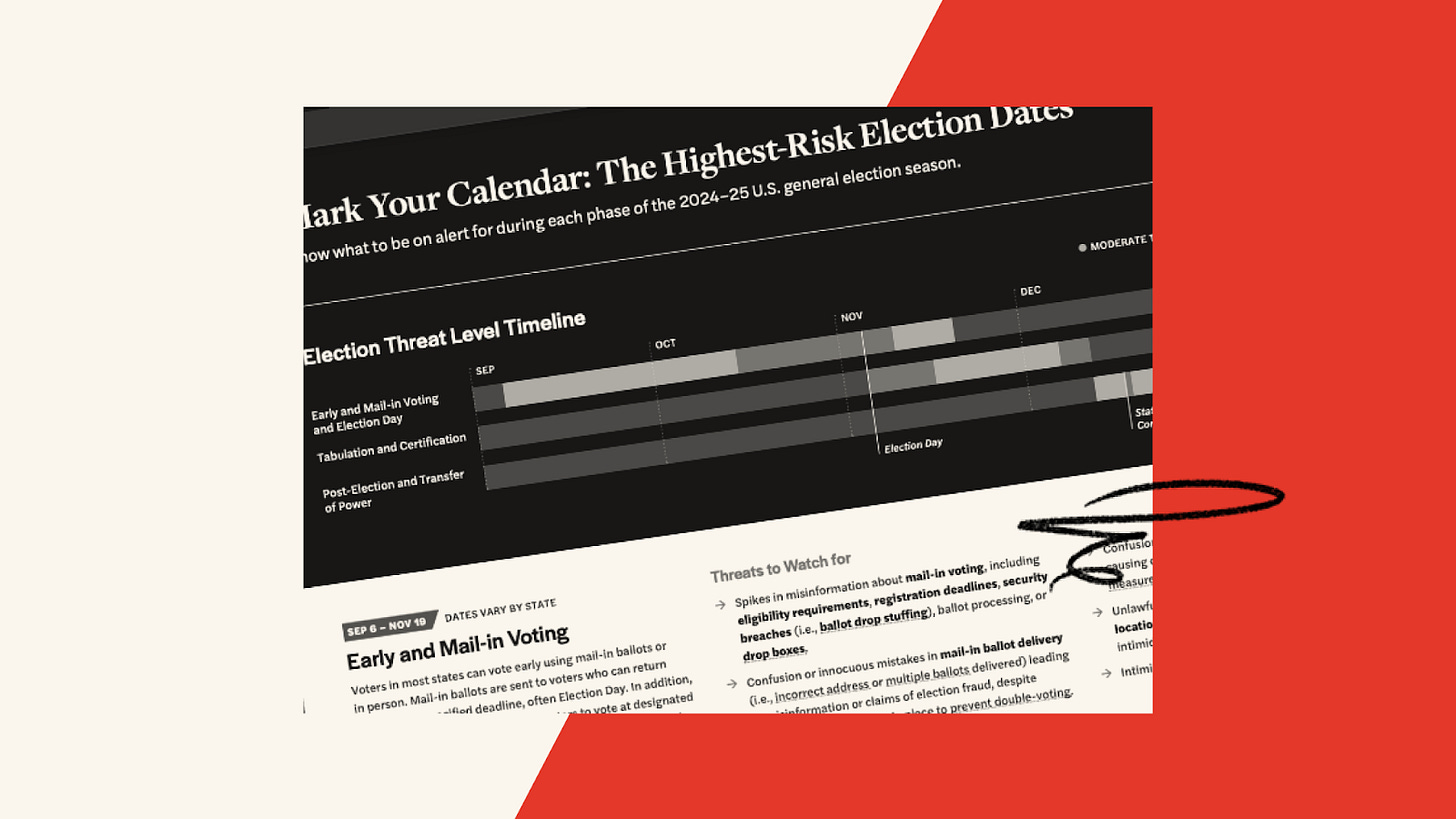How tech companies can help secure the election after Election Day
Critical dates, procedures, and threats between voting and the inauguration
This Insights post is co-published with
by Protect Democracy.Once the media projects a winner of a presidential election, most of us typically think it’s safe to step away from the 24/7 coverage and consider the election “done.” Rare cycles like 2000 or 2020 reminded us of the complex process that follows Election Day, a multi-phased operation that begins with ballots being counted and and continues until Inauguration Day. Regardless of when the race gets called this cycle, the election process and transfer of power to a new president will not be complete until January 20th, 2025.
As November 5th draws near, we must pay attention to this period between Election Day and Inauguration Day, which is particularly vulnerable to misinformation, violence, and attempts to interfere with a peaceful transition.
This is true for all Americans — but the preparation can be especially daunting for technology companies working to protect the integrity of elections on their platforms. And the stakes are high. While much may be uncertain regarding the 2024 cycle, it has left no doubt that social media, messaging, and generative AI platforms are critical sources and conduits of election information.
After Election Day, platforms will be on the frontlines as the country awaits and ultimately processes the presidential race’s results. The confusion, lies, threats and harassment that will likely emerge online present not only significant brand and reputational risks to these companies, but all-too-real potential for offline consequences, including violence.
Protect Democracy and Anchor Change have teamed up with current and former election officials and other experts to break down exactly what happens during this critical time and offer recommendations for how tech platforms can be prepared for all possibilities.
A changed electoral landscape
In anticipating what to expect after Election Day, it’s important to consider how the legal and political landscape surrounding our elections has shifted. According to the Bipartisan Policy Center, over 9,000 bills on election issues were introduced in state legislatures since 2020, 900 of which were enacted into law. In addition, Congress passed the Electoral Count Reform Act (ECRA) in 2022, which aimed to clarify and strengthen procedures for counting electoral votes.
In parallel, the people and processes central to election administration have been increasingly under fire. Election workers have faced a surge in threats of harassment and violence. County officials in five battleground states — Arizona, Georgia, Michigan, Nevada, and Pennsylvania — have attempted to block the certification of election results, although none have succeeded.
Moreover, the period after Election Day will likely be a target for foreign adversaries intent on interfering in the election. As the National Intelligence Council recently warned, “Some foreign actors may conduct activities that seek to disrupt or delay the time-sensitive and tightly sequenced series of processes and events that begin after polls close. Each step, from the tabulation of votes and certification of results to completion of the Electoral College process and inauguration, is potentially susceptible to foreign influence and interference operations in different ways.”
Public perception will also likely play a significant role in the post-Election Day period. A recent poll by the Public Affairs Council revealed four out of ten Americans believe violent protests will occur regardless of the election’s outcome, and nearly half anticipate violence specifically if Donald Trump loses. These trends underscore the importance of preparedness and proactive measures to support the election’s safe and secure administration through Inauguration Day.
An election threat calendar
Looking across the three remaining phases of the 2024 cycle, we’ve identified a shortlist of the highest-risk dates. Of the six highest-threat periods, five occur after Election Day and outside of voting.
[See the election threat calendar]
Post-Election Day state procedures: tabulation and certification
Local and state officials are responsible for completing a complex series of steps to ensure ballots are accurately counted. These steps vary from state-to-state, but typically begin with (1) processing mail-in ballots to validate their authenticity and integrity, (2) tabulating results (with mail-in ballots tabulated separately from in-person votes), and (3) reporting unofficial results, also known as “election night reporting,” when local and state election websites publish initial vote totals. These initial totals typically don’t account for two sets of ballots: provisional ballots, ballots cast in-person by individuals whose eligibility is in question and must later be verified, and cured ballots, mail-in ballots that had errors when submitted which voters are allowed to correct during a defined period.
November 5th - 15th marks a high-risk period as the days when local and state officials will likely be tabulating ballots. Confusion and threats to anticipate include
Concern and controversy resulting from a red or blue mirage;
Delays or confusion regarding election procedures resulting in claims of fraud such as ballot tampering, destruction or replacement; and
Harassment and violence directed at election workers, polling locations or ballot counting facilities.
After tabulation is complete, local election officials meet to canvass and confirm the official vote count. A local canvass entails a rigorous collecting and checking of all ballot materials to identify any discrepancies in vote counts or turnout rates, including building a chain of custody for each and every ballot. It can also include performing post election audits or recounts — although the timing and requirements for triggering these additional checks varies across states (and, depending on the state, they can occur later in the process). Once a local canvass is complete, county officials certify the election results. These results are then transmitted to a state’s election authorities who repeat the canvass and certification process for statewide races, ballot measures, and contests that span multiple counties.
As a result of the ECRA’s passage, states for the first time have a deadline (December 11th) by when they must certify results and appoint their electoral slates. Given this, December 5th - 11th is a high-risk period when the following may emerge leading up to that deadline:
Threats or violence targeting local or state election officials, including the sites where they convene for local or state canvasses; and
Attempts to delay or derail local or state certification, including county or state officials refusing to certify results.
The post-election national milestones: the Electoral College, joint session of Congress, and Inauguration Day
The final phase of election administration consists of three national milestones: (1) The convening of the Electoral College on December 17th when electors meet in each state to cast their votes; (2) the joint session of Congress on January 6th when the newly sworn-in Congress counts electoral votes; and (3) Inauguration Day on January 20th when the president-elect and vice president-elect are sworn in.
As the building blocks to a peaceful transfer of power, the days surrounding these steps are high-risk periods, specifically December 11th - 17th; January 3rd - 6th; and January 20th. Across all three, we anticipate threats will concentrate on the people, places and procedures that are fundamental to each milestone such as
Fake or faithless state electors (electors who vote for someone other than whom they have pledged their vote);
Coercion or violence targeting state electors, members of Congress or the sites of their convenings; and
Harassment or violence endangering the public swearing-in on Inauguration Day.
How tech platforms can prepare
Previous cycles have demonstrated that online platforms play a significant role in protecting the integrity of election administration and the information environment that surrounds it. With limited time remaining, we urge these companies to ensure their preparations and playbooks are ready for what’s in store for our democracy after Election Day.
In doing so, companies don’t need to start from scratch, but can extend and adapt the best practices and strategies they’ve honed to safeguard other elements of election integrity, including
Team resourcing and internal escalations: Establishing clear escalation processes to navigate fast-evolving and uncertain scenarios, including a clear assignment of decision-making authority and designated point person to lead external comms.
Engaging with external stakeholders: Building relationships with election officials, law enforcement, civil society, political campaigns, and news organizations for effective real-time information-gathering and coordination.
Monitoring and enforcing on on-platform activity: Monitoring on-platform activity for threats and emerging trends, especially indicators of harassment or violence that are targeting specific individuals or locations. This monitoring should be paired with documented criteria and playbooks to assess borderline content and deploy break-the-glass levers.
Sourcing & directing users to authoritative information: Offering users clear and accessible sources of accurate election information, especially to offer context on the steps and stages that occur after Election Day. This can also include directing users to off-platform authoritative sources where they can find updates and track the election’s progress.
Voting is in flight across the country, but there is still time for platforms to invest in these risk mitigation measures. In doing so, they could meaningfully impact the degree to which the remainder of the election is conducted freely, fairly, and peacefully.
What’s absolutely critical with now less than two weeks until November 5th is that all of us who are engaged in the work of safeguarding the 2024 cycle — no matter the sector we hail from — recognize the job doesn’t end on Election Day. We’re in it, together, for the long haul — which is to say, in the context of this cycle, through January 20th.
Please support the curation and analysis I’m doing with this newsletter. As a paid subscriber, you make it possible for me to bring you in-depth analyses of the most pressing issues in tech and politics.








